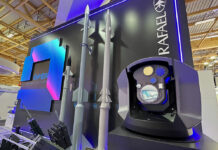Above: Ground in Arizona, as part demonstrating the solar powered drone’s capability to fly a two week mission. Photo: QinetiQ
Zephyr, the solar-powered, high altitude long endurance (HALE) unmanned vehicle developed by QinetiQ has been flying for the past week, smashing a number of long-standing world records.
The solar powered drone mission continues above the US Army’s Yuma Proving Ground in Arizona, as part demonstrating the solar powered drone’s capability to fly a two week mission. “By being able to remain over a location for weeks or months at a time, it can usefully deliver a host of practical and more affordable solutions to both civil and military customers” said Jon Saltmarsh, Zephyr Program Director at QinetiQ.
A Larger Zephyr
The current goal is to fly for a further week and prove Zephyr is the world’s first truly eternal plane, capable of providing a low-cost, persistent surveillance capability over months rather than days. Potential applications include earth observation and communications relay in support of a range of defense, security and commercial requirements.
Unlike conventional manned or unmanned aircraft now being operated, Zephyr does not need to return to base at regular intervals for re-fuelling or servicing which also helps minimize the logistical supply chain and extend its operational capability.
Around 50% larger than the previous Zephyr, technical changes now mean it has a 22.5m wingspan to accommodate more batteries that are combined with a totally new integrated power management system. The entirely new aerodynamic shape and high “T” tail also contribute to reduce drag and improve performance. The payload capacity will meet a number of key surveillance and communication requirements already demonstrated by Zephyr over the past three years. Zephyr’s ultra-lightweight carbon-fibre design also means it weighs in at just over 50Kg.
“The current Zephyr aircraft is a genuine breakthrough design, drawing on the latest technology and represents a massive leap forward in engineering excellence incorporating an entirely new wing design.” Saltmarsh explained. Launched by hand, the aircraft flies by day on solar power delivered by amorphous silicon solar arrays no thicker than sheets of paper that cover the aircraft’s wings. These are also used to recharge the lithium-sulphur batteries, supplied by Sion Power Inc, which are used to power the aircraft by night. Together they provide an extremely high power to weight ratio on a continuous day/night cycle, thereby delivering persistent on-station capabilities.
Claiming the World Endurance Record for UAVs
On July 23, 2010 Zephyr successfully landed after 14 days (336 hours) and 21 minutes flying over Arizona. and is now awaiting official confirmation of its world record status. Following the flight, QinetiQ is claiming three world records for the Zephyr:
- the absolute duration record for an Unmanned Air Vehicle – being filed at 336 hrs / 22 minutes
- the duration record for a UAV (in the U/1.c / 50-500Kg category) – time as above
- the absolute altitude record for a UAV (in the above category) – being filed at 70,740ft (21,561m)
This record far exceeds the unofficial world record for longest duration unmanned flight of 82 hours, 37 minutes set in 2008 and already held by Zephyr, and is well in excess of the current official world record of 30 hours 24 minutes set by Northrop Grumman’s RQ-4A Global Hawk on 22 March 2001. Upon landing, plans to claim the world record for HALE UAV flight endurance. The company invited the Federation Aeronautique Internationale (FAI), the world air sports federation, to oversee the flight and an FAI Official has been monitoring progress at the Yuma Proving Ground.
QinetiQ was awarded $45 million by the U.S. Navy for the delivery of seven Zephyrs, QinetiQ will produce the Zephyrs at Farnborough, in the United Kingdom. The seven aircraft are expected to be delivered win 2014.





















